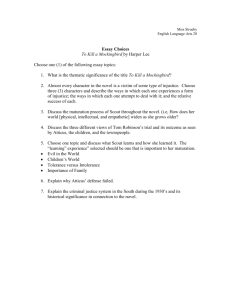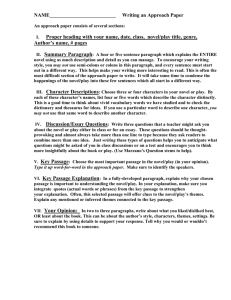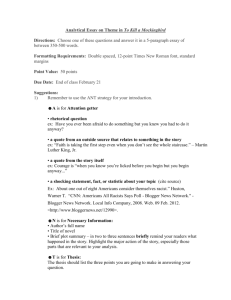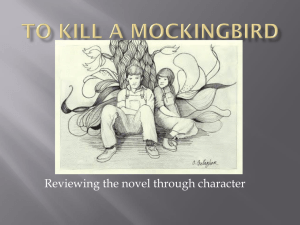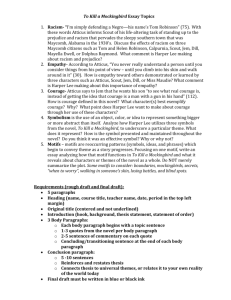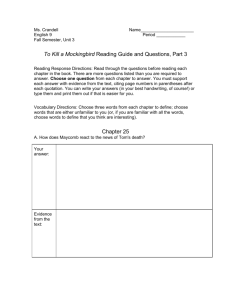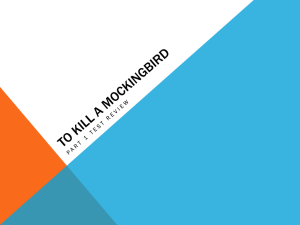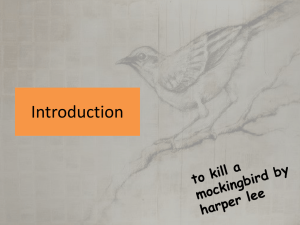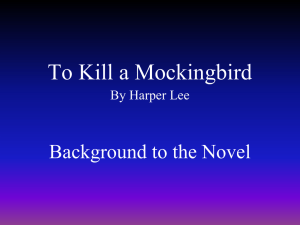Writing an Approach Paper
advertisement
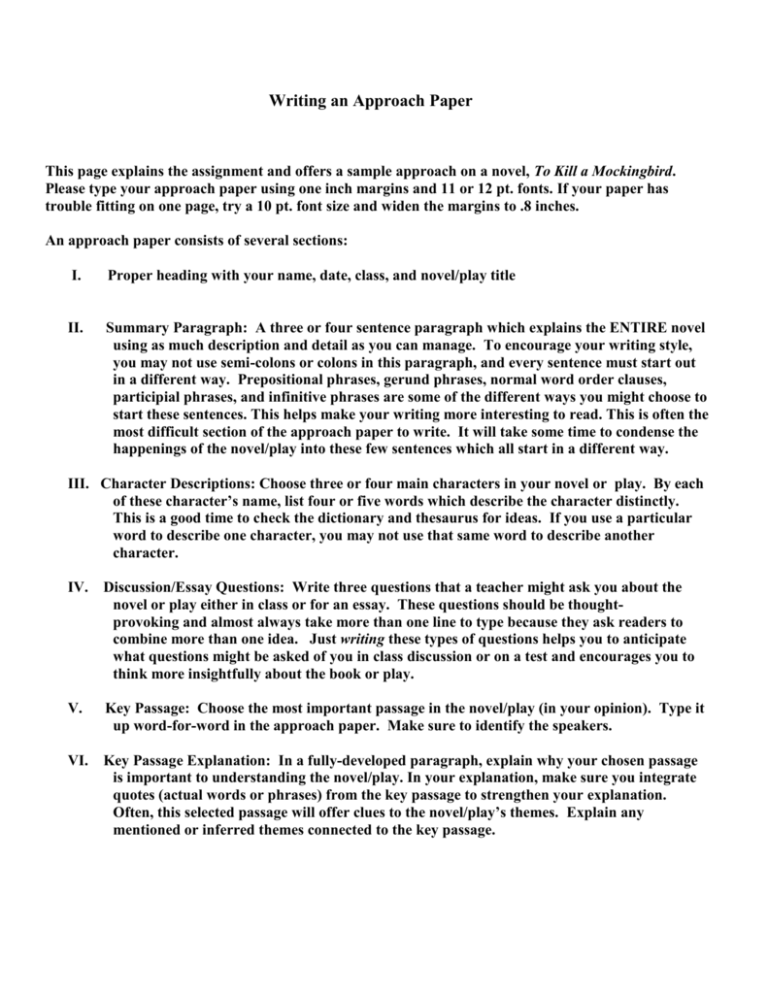
Writing an Approach Paper This page explains the assignment and offers a sample approach on a novel, To Kill a Mockingbird. Please type your approach paper using one inch margins and 11 or 12 pt. fonts. If your paper has trouble fitting on one page, try a 10 pt. font size and widen the margins to .8 inches. An approach paper consists of several sections: I. Proper heading with your name, date, class, and novel/play title II. Summary Paragraph: A three or four sentence paragraph which explains the ENTIRE novel using as much description and detail as you can manage. To encourage your writing style, you may not use semi-colons or colons in this paragraph, and every sentence must start out in a different way. Prepositional phrases, gerund phrases, normal word order clauses, participial phrases, and infinitive phrases are some of the different ways you might choose to start these sentences. This helps make your writing more interesting to read. This is often the most difficult section of the approach paper to write. It will take some time to condense the happenings of the novel/play into these few sentences which all start in a different way. III. Character Descriptions: Choose three or four main characters in your novel or play. By each of these character’s name, list four or five words which describe the character distinctly. This is a good time to check the dictionary and thesaurus for ideas. If you use a particular word to describe one character, you may not use that same word to describe another character. IV. Discussion/Essay Questions: Write three questions that a teacher might ask you about the novel or play either in class or for an essay. These questions should be thoughtprovoking and almost always take more than one line to type because they ask readers to combine more than one idea. Just writing these types of questions helps you to anticipate what questions might be asked of you in class discussion or on a test and encourages you to think more insightfully about the book or play. V. Key Passage: Choose the most important passage in the novel/play (in your opinion). Type it up word-for-word in the approach paper. Make sure to identify the speakers. VI. Key Passage Explanation: In a fully-developed paragraph, explain why your chosen passage is important to understanding the novel/play. In your explanation, make sure you integrate quotes (actual words or phrases) from the key passage to strengthen your explanation. Often, this selected passage will offer clues to the novel/play’s themes. Explain any mentioned or inferred themes connected to the key passage. Jennifer Crowley English III October 22, 2001 To Kill a Mockingbird Approach Paper To Kill a Mockingbird by Harper Lee is the story of three years in the childhood of Scout and her older brother Jem. As an adult narrator, Scout recalls a series of loosely connected episodes which occur in Maycomb, Alabama, in the 1930s, a time of racial segregation and extreme prejudice. Weaving two strands of narrative, Lee presents Boo Radley, the mysterious and reclusive neighbor whom the children find both intriguing and frightening, with the trial of Tom Robinson, a hardworking, innocent black man who is being defended by Scout and Jem’s just and courageous father, Atticus Finch. The two strands of narrative tie together in the end when Boo Radley emerges from his seclusion to save Scout and Jem from a cowardly attack on them by Bob Ewell, who vowed vengeance on Atticus after the trial. Scout Finch: strong-willed, intelligent, tomboyish, loyal, quick-tempered Jem Finch: thoughtful, steadfast, imaginative, maturing Atticus Finch: just, courageous, insightful, determined Boo Radley: reclusive, lonely, simple, protective 1. To Kill a Mockingbird deals with the issue of racial equality, but Harper Lee also includes the strong story line of Boo Radley. How does the Tom Robinson trial combine with the Boo Radley story thread to make a novel that speaks powerfully of more than just racial equality? 2. What do Jem and Scout finally understand about their father: what he stands for in their own lives and in the lives of many of the townspeople? 3. Discuss the three different views of Tom Robinson’s trial and its outcome as seen by Atticus, Jem and Scout, and the townspeople. From Chapter 3, page 30: Atticus: “First of all,” he said. “if you can learn a simple trick, Scout, you’ll get along a lot better with all kinds of folks. You never really understand a person until you consider things from his point of view...until you climb into his skin and walk around in it.” Atticus’ entire philosophy of life seems to be summed up in his words to Scout. To be an objective and just community member, one must be able to “climb into” another person’s “skin” and “walk around in it” or be able to see issues from another person’s perspective. Atticus offers these words to Scout after her first day of formal schooling in the first grade when she is upset that the teacher doesn’t understand her efforts to explain Walter Cunningham’s financial situation. These words from Atticus begin her first lessons in life. Through the course of the novel, Atticus will show the children his compassion for people different from their family, his attempts to “climb into someone’s skin and walk around in it” when he defends an innocent black man, Tom Robinson, against a town’s wishes, and when he instructs the children to be respectful and compassionate toward Boo Radley, a neighborhood recluse. One of the main themes of the novel is understanding and accepting people different from oneself. Grading Rubric Overall Format 40 points Section I 10 points Section II 10 points Section III 10 points Section IV 10 points Section V 10 points Section VI 10 points Total possible points 100 Final grade _______ Comments
